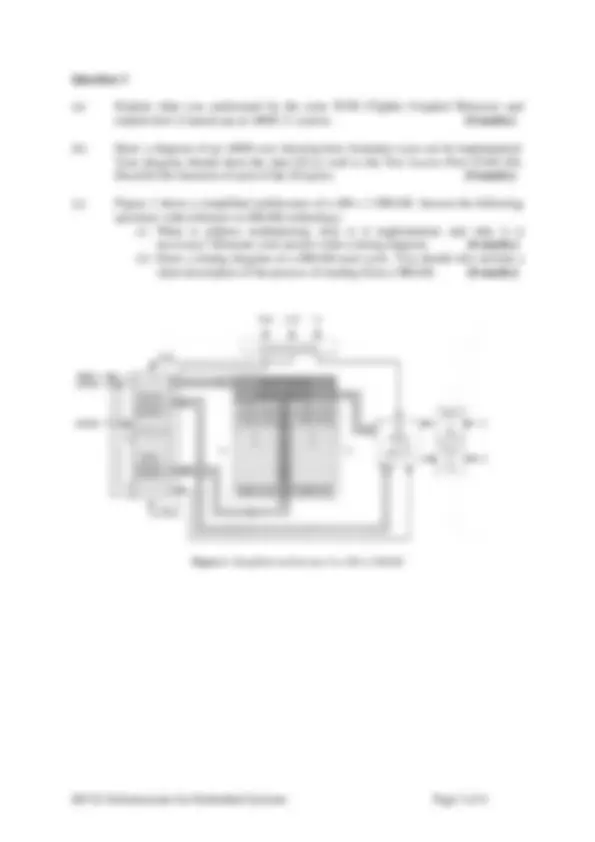




Study with the several resources on Docsity

Earn points by helping other students or get them with a premium plan


Prepare for your exams
Study with the several resources on Docsity

Earn points to download
Earn points by helping other students or get them with a premium plan
Community
Ask the community for help and clear up your study doubts
Discover the best universities in your country according to Docsity users
Free resources
Download our free guides on studying techniques, anxiety management strategies, and thesis advice from Docsity tutors
Main points of this exam paper are: Holter Monitor, Portable Electronic Device, Specification Requires, Analogue Channels, Electrocardiography, Mobile Phone, Microprocessor Architecture, Power Consumption, Limited Storage Capacity, Limited Capability
Typology: Exams
1 / 4

This page cannot be seen from the preview
Don't miss anything!



Semester I Examinations 2010/
Exam Code(s) 3BP Exam(s) Third Electronic and Computer Engineering
Module Code(s) EE Module(s) Infrastructure for Embedded Systems
Paper No. 1 Repeat Paper No
External Examiner(s) Prof. G. W. Irwin Internal Examiner(s) Prof. G. Ó Laighin Dr. M. Glavin
Instructions: Answer any three questions. All questions carry equal marks (20 marks).
Duration 2hrs No. of Pages 4 Discipline Electrical & Electronic Engineering Course Co-ordinator(s)
Requirements : MCQ Handout Statistical Tables Graph Paper Log Graph Paper Other Material
You are given the task of designing a Holter monitor (a portable electronic device for measuring and recording the electrical activity of the heart). The specification requires that your design will record four analogue channels of electrocardiography (ECG), connect with a GSM mobile phone and send the results (up to a limit of 100kB of data) to the heart clinic once a day to allow the doctor to monitor the status of their patient over a period of a week.
What are the major design decisions that must be taken into account when designing such a device? Your answer should take each of the following into consideration: (i) Microprocessor architecture (CISC, RISC, DSP, or SoC ASIC). Discuss each architecture and assess its suitability for this application. [8 marks] (ii) Power consumption. [4 marks] (iii) Limited storage capacity and limited capability to send large amounts of data over the GSM network could both be a problem. How could this problem be addressed and what are the implications of your solution in terms of computational requirements, power consumption, memory or other factors? [4 marks] (iv) Draw a block diagram of your proposed system showing each of the main components. [4 marks] Clearly state any assumptions you make about the environment or the technology which might influence your design choices.
Question 2
In your practical work throughout this course, you have worked on a group project which involved writing C code and Java to interface a mobile phone and a toothpick microcontroller to control a small robot. With regard to your team’s efforts on the development of the robotic system:
(i) Draw a block diagram of the robotics system, showing the system components, and detailing the signals passed between sub-systems. [5 marks] (ii) How does an interrupt-based embedded C program (such as that on the toothpick) differ from a normal C program you might write on a desktop PC? Illustrate your answer with examples from your work on this project. [5 marks] (iii) Describe the algorithm you developed to control the digital output pins on the toothpick to control the motors on the robot. Use a block diagram, pseudocode or C code as appropriate. [5 marks] (iv) Describe how you controlled the robot using the mobile phone. What commands did you issue from the phone and how were they interpreted by the toothpick? [5 marks]
(a) List, and briefly discuss, five reasons why you might consider using a Real Time Operating System in an embedded system. [5 marks]
(b) List five ways in which loops can be made more efficient in C on an embedded system through careful program design (explain why they execute more efficiently, and illustrate your answer with an example where appropriate). [5 marks]
(c) All embedded systems generate, and are susceptible to Electromagnetic Interference (EMI). (i) Outline some of the ways in which an embedded system might generate significant EMI. [2 marks] (ii) How does EMI usually manifest itself as a problem? [2 marks] (iii) Can you suggest some ways in which this interference might be suppressed? [2 marks] (iv) How can a printed circuit board be modified to improve a system’s EMC? [2 marks] (v) What are the problems with non-compliance with EMC regulations? [2 marks]